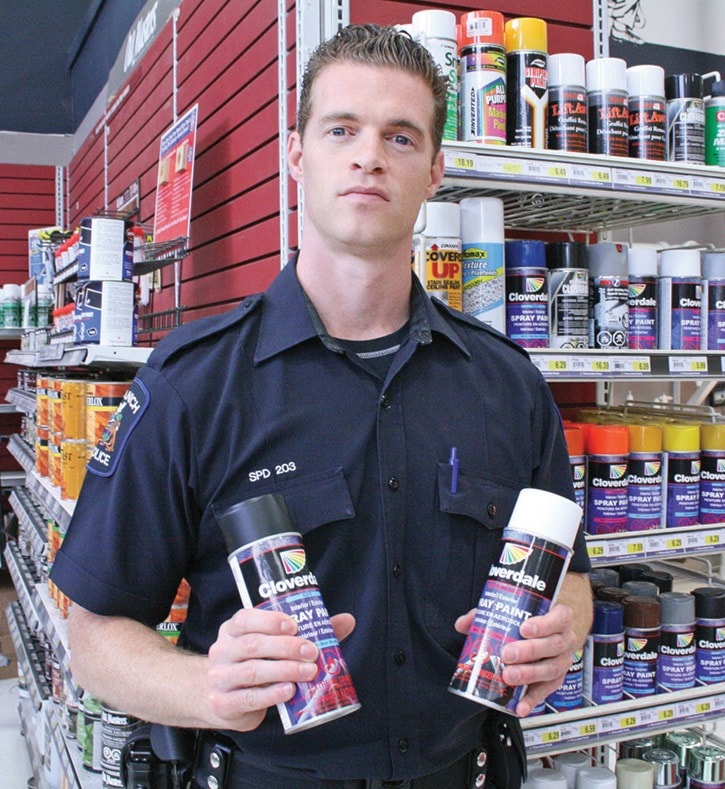Graffiti vandals usually start by scribbling their nameplate, or tag, with permanent marker along telephone poles, mailboxes and school walls close to home.
But the longer those “bubblegum level” tags are left unchecked, the more likely they’ll progress into prolific – and costly – vandalism for Saanich or any other community, says Saanich police Const. Mark Pamminger.
“Leave tags there for a month, and it might as well be a 4,000 per cent chance of increase,” says Pamminger, who leads Saanich PD’s anti-graffiti program.
In Saanich, the battle against tagging has made great strides in a short period of time, though it remains an ongoing problem. The community has come forward to help paint over and reclaim tagging “hotspots,” such as the Seaton Street pedestrian underpass, Mount Tolmie, Tillicum Bridge and areas along the Galloping Goose and Lochside trails. Tags have also been increasing in Gordon Head recently. While residents tend to associate an increase in graffiti with other types of crime, Pamminger says property crime and tagging aren’t usually connected.
“Generally speaking, there is a decrease in crime (in Saanich), but graffiti is the most visible crime in our community,” he says. “Graffiti promotes an image that an area is unsafe and it can attract other crimes. This is why it’s important to report and clean up the graffiti immediately.”
A former hotspot is Tolmie Lane, which borders Victoria and Saanich on the east side of Douglas Street. Like the Seaton Street tunnel below the Trans-Canada Highway, Tolmie Lane is now largely tag-free, thanks to community initiative and a surge of clean-up work.
“My predictions were the graffiti would come back quickly, but we’ve had maybe just a few tags since the (organized) paint out,” says Ashley Galaude, service advisor at Rand Automotive, a major tenant that backs onto the alley. “Anything that’s shown up, we’ve been on top of it and painted over it right away.”
Galaude was part of a spring clean-up that drew volunteers from Target, B.C. Hydro, Telus and other neighbours. A similar initiative took place near Tillicum Centre last month.
The paint out also helped limit the laneway’s other ongoing issue of dumping, which has been less frequent since the tags were removed, Galaude says.
The only way to truly stop graffiti vandalism is to remove it immediately, says Pamminger, who has been delving deep into the mind of the suburban tagger. He’s currently implementing several targeted anti-graffiti investigation techniques that he hopes will garner successful charges against a few key individuals.
“The most prolific taggers keep doing it into their late teens and then their 20s,” he says. “It’s a small minority doing the great majority of the tagging we see.”
On a larger scale, increased patrols by Saanich police officers and Saanich public works crews are integral after an area cleanup.
The end goal is to slow and eventually stop the ongoing ritual of graffiti that exists in Saanich’s suburban areas. But catching a vandal in the act – thereby securing a definitive connection between a suspect and their tag – isn’t so easy.
“They know it’s something they can be caught for, so they’re careful not to be caught, but they want to be seen,” Pamminger says.
Many vandals who leave a trail of tags are actually skilled artists, he adds. But when those artists don’t see their tagging as a crime, it’s a problem.
Other strategies, such as a designated graffiti wall, have also proved ineffective. Graffiti walls end up inviting additional tags or vandalism to the area as the perpetrators seek a fresh canvas to paint on.
A typical prolific tagger will leave his or her home and then leave a trail of tags throughout a neighbourhood, and some taggers share their work on social media for bragging rights. Pamminger cautioned people not to share those posts, as it gives taggers exactly what they want.
In Pamminger’s experience, parents are usually unaware of the tools used for graffiti. It’s not necessarily spray paint cans. Many taggers use black, white and fluorescent permanent markers.
If you see a tag in Saanich, notify police by calling the non-emergency line at 250-475-4321. Call 911 to report illegal tagging in progress.
reporter@saanichnews.com
Did you know?
- Each tag is a signature word or acronym used for several years. Because of this, police are able to develop intelligence on prolific offenders.
- Saanich currently spends about $100,000 annually on graffiti removal.
